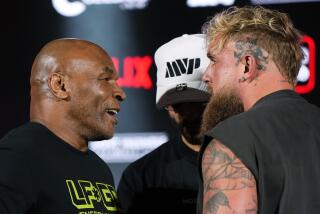THE SEOUL GAMES : ‘Tough Draw’ for U.S., Boxing Coach Claims
- Share via
SEOUL — After 2 hours 50 minutes of watching young South Korean women shake Ping-Pong balls around in a cardboard box at the Olympic Games’ boxing tournament draw Friday, U.S. boxing coach Ken Adams looked at the final draw sheet and shrugged.
“Some of our kids are in tough, some look pretty good. . . . Overall I’d say it’s a tough draw for us, but it could’ve been worse,” he said.
Three of Adams’ boxers drew opening-round bouts against South Koreans, considered one of the stronger teams here. The first U.S. athlete to box will be flyweight Arthur Johnson, who meets Italy’s Andrea Mannai Sunday morning.
Also Sunday, U.S. world champion featherweight Kelcie Banks opens against the Netherlands’ Regilio Tuur in the evening session.
Here’s the United States’ first-bout schedule for the Olympics’ 15-day boxing tournament, which has a record 441 boxers from 140 countries:
106 pounds--Michael Carbajal vs. Oh Kwang-Soo (South Korea), Wednesday.
112--Arthur Johnson vs. Andrea Mannai (Italy), Sunday.
119--Kennedy McKinney vs. Erick Giovinni Perez (Guatemala), Thursday.
125--Kelcie Banks vs. Regilio Tuur (the Netherlands), Sunday.
132--Romallis Ellis vs. Lee Kang-Suk (South Korea), Friday.
139--Todd Foster vs. Kampompo Miango (Zaire), Friday.
147--Ken Gould vs. Joseph Marwa (Tanzania), Tuesday.
156--Roy Jones vs. Mendere Makalamba (Malawi), Saturday, Sept. 24.
165--Anthony Hembrick or Jerome James vs. Ha Jong-Ho (South Korea), Monday.
178--Andrew Maynard vs. Mikaele Masoe (American Samoa), Sunday, Sept. 25.
201--Ray Mercer vs. Rudolf Gavenciak (Czechoslovakia), Monday, Sept. 26.
201+--Riddick Bowe vs. Biko Botowamungu (Austria), Monday, Sept. 26.
Johnson will face an Italian who won a preliminary bout in the 1986 World Championships at Reno before losing in the quarterfinals to Cuba’s Pedro Reyes, 5-0.
Banks, the world champion and Pan American Games champion, figures as a solid favorite against Tuur.
Ellis and Hembrick or James, who also open against South Koreans, will try to take the South Korean-dominated crowds out of the tournament early, Adams said.
“Obviously, the best thing for us would be for our kids to beat those South Koreans straight off, and hopefully the South Korean crowds will come over to our side,” Adams said.
“We expect the South Koreans to be typically aggressive, wading in on us all the way. But we want our kids to make them back up, which they don’t like to do.
“I can assure you of one thing, we’re physically ready. There isn’t one kid on our team who can’t go out there and throw punches for nine minutes, not one.”
The United States’ two big men, heavyweight Ray Mercer and super-heavyweight Riddick Bowe, did not draw tough first-round assignments, but may have difficulty in the quarterfinals and semifinals.
Mercer drew a Czechoslovakian, Gavenciak, and Bowe drew an African boxer competing for Austria, Botowamungu. But Mercer, if he wins, would probably meet a world-class boxer in the quarterfinals, the Netherlands’ Towering Tulip, Arnold Vanderlijde, a 6-foot 7-inch hit-and-run specialist who won a silver medal at the 1986 World Championships.
Bowe is in the top half of the super-heavyweight bracket with the Soviet Union’s Alexander Miroshnichenko, a solid medal favorite.
Maynard, the U.S. light-heavyweight and a solid medal favorite, has perhaps the easiest draw of any on the U.S. team. He is in the top half of the bracket, where the only tough opponents appear to be from Hungary and South Korea.
After the draw, Adams and his assistants returned to the athletes’ village with one message for their boxers.
“I’m going to tell the kids who drew tough opening-round bouts that the best way in the world to get momentum started is to win,” he said.
“Beat that first tough guy, and you’re on your way.”
As expected, the International Amateur Boxing Assn. (AIBA) elected to use the excruciatingly slow but trustworthy pluck-the-Ping-Pong-balls-out-of-the-box method to seed the tournament.
A computer could have drawn the entire tournament in five minutes.
“It’s the same old story, the East Bloc countries and some others suspect a U.S. trick if you even suggest using a computer,” said Jim Fox, USA Amateur Boxing Federation executive director.
Stan Hamilton, veteran U.S. judge/referee, explained how the new guideline for judges’ selections will work for this tournament. At Los Angeles in 1984, all five judges for every bout had to be from a neutral continent.
“That may be the case for many of the bouts here,” Hamilton said.
“But the referees and judges commission also has decided that there can be two judges from the same continent as the boxers, and three neutrals. Or it can also be four from the same continents, and one neutral.
More to Read
Go beyond the scoreboard
Get the latest on L.A.'s teams in the daily Sports Report newsletter.
You may occasionally receive promotional content from the Los Angeles Times.






